New Data Reveals the Stark Realities for Nonprofits During COVID-19

In a time when many nonprofits are facing a simultaneous decrease in revenue and an increase in demand for services, findings from a new survey conducted by CEP provide a comprehensive look at the on-the-ground circumstances U.S. nonprofits are facing during the COVID-19 crisis.
Based on a nationally representative survey of nonprofit leaders conducted in May, Funder Support During the COVID-19 Pandemic reveals which organizations are facing the toughest challenges and what differences in experience are emerging based on characteristics such as organization type and gender of nonprofit leaders.
The study also identifies what nonprofit leaders say they need most from both institutional foundations and individual donors alike in the current moment. Funders can do more to support nonprofits — especially those that provide direct services and serve historically disadvantaged communities — by providing more funding, providing unrestricted funding, and reaching out to provide transparency about how the pandemic will impact future support, nonprofit leaders say
CEP presented the findings during a webinar earlier this month, which also included a frank discussion with nonprofit leaders Chitra Hanstad of World Relief Seattle and Stephanie Hull of Girls, Inc., along with Melinda Tuan of Fund for Shared Insight, about the challenges nonprofit leaders are facing right now. Watch the recording of the conversation here, and download the presentation slides to share the data with colleagues, board, and staff.
Discussing the findings on the CEP blog, Analyst Kate Gehling writes: “We know that funders’ actions can profoundly impact nonprofit organizations and the people and communities they serve. But to know how to be as supportive as possible, it’s essential that funders understand what nonprofits are going through right now — and hear about these realities straight from the source.”
Download the report here.
Foundations and Policy Influence: A New CEP Research Report
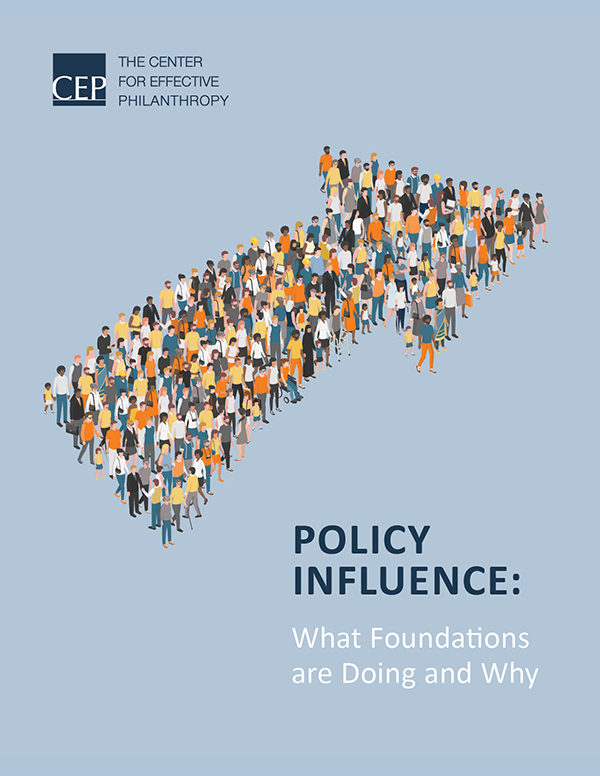
How many foundations are working to influence policy? What are they seeking to accomplish through this work? What do they find to be the best approaches and biggest challenges to achieving those goals?
To find answers to these questions (among others), CEP studied the perspectives of foundation leaders across the country, publishing our findings last month in a new report titled Policy Influence: What Foundations are Doing and Why. CEP’s hope is that the findings will help foundations approach their efforts to influence public policy more thoughtfully — which is all the more important right now given the COVID-19 pandemic and accompanying economic crisis.
The study finds that foundation leaders strongly believe that efforts to influence public policy are an important way to achieve their goals. However, though these efforts have increased in recent years, they remain a small portion of most foundations’ work. Additionally, the study finds that most foundations are collaborating with others and supporting grantees’ efforts as a means to achieving their policy goals, rather than going it alone, but face common challenges in their efforts (namely, building board support emerged as the most frequent challenge).
How many foundations are working to influence policy? What are they seeking to accomplish through this work? What do they find to be the best approaches and biggest challenges to achieving those goals?
To find answers to these questions (among others), CEP studied the perspectives of foundation leaders across the country, publishing our findings last month in a new report titled Policy Influence: What Foundations are Doing and Why. CEP’s hope is that the findings will help foundations approach their efforts to influence public policy more thoughtfully — which is all the more important right now given the COVID-19 pandemic and accompanying economic crisis.
The study finds that foundation leaders strongly believe that efforts to influence public policy are an important way to achieve their goals. However, though these efforts have increased in recent years, they remain a small portion of most foundations’ work. Additionally, the study finds that most foundations are collaborating with others and supporting grantees’ efforts as a means to achieving their policy goals, rather than going it alone, but face common challenges in their efforts (namely, building board support emerged as the most frequent challenge).
For the full data and findings, download the report here. Additionally, learn more about the key findings in The Chronicle of Philanthropy’s coverage of the study here.
Findings in the report have been the topic of conversation in a number of insightful pieces on the CEP blog:
- Naomi Orensten, director, research, at CEP and co-author of the report, discusses why the study’s findings and takeaways are especially crucial for funders to consider in today’s much-changed context.
- CEP Analyst Kate Gehling, another of the report’s co-authors, shares examples and insights — gleaned from interviews with foundation leaders — about the role of collaboration in effective policy-change work, which could not fit into the report.
- Lisa Ranghelli, senior director of evaluation and learning at NCRP, describes how funders can make their policy-change practices match their aspirations by focusing on equity.
- Celine Coggins, executive director of Grantmakers for Education, offers five considerations for policy-oriented funders seeking “to build a strategy that is both authentic to the voice of communities in need as well as politically pragmatic.”
- Ruth Levine, CEO of IDinsight, discusses the specific challenges and opportunities for foundations working on policy and advocacy abroad.
- Grantmakers in Health (GIH) Program Advisor Eileen Salinsky puts CEP’s findings into conversation with data on GIH’s funding partners, arguing that policy-change strategies remain underutilized by health funders.
The findings of Policy Influence also raise a number of important questions for foundation staff and boards to consider. CEP asked several funders active in the policy realm — in a variety of ways, across a variety of issue areas, utilizing a variety of policy tools — to share their thoughts on these questions, which will be published in an upcoming Q&A series on the CEP blog next month. Stay tuned.
Upcoming Virtual Conversations
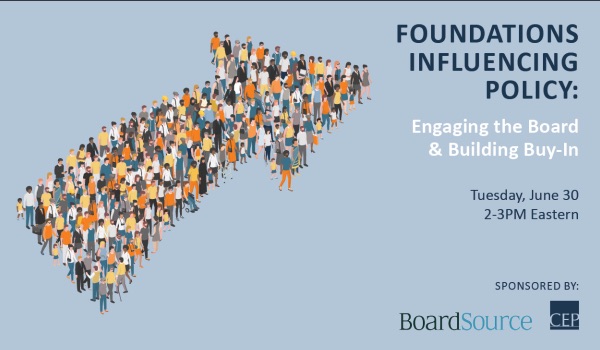
CEP leaders have been busy sharing data and insights in virtual conversations about this critical moment for nonprofits and philanthropy. Upcoming webinars include:
June 30 (Tomorrow!): Foundations Influencing Policy: Engaging the Board & Building Buy-In
This webinar will feature findings from CEP’s recent report, Policy Influence, and will draw on BoardSource’s Stand for Your Mission campaign, an effort calling on board members to be advocates for their missions. Discussion will explore the top challenge that foundation leaders face in their policy efforts — building board support — and participants will gain insight and practical tools for effectively engaging their board in the policy realm.
July 8: Strengthening and Building Effective Relationships Between Nonprofits and Funders
Hosted by Philanthropy Massachusetts, this webinar featuring CEP’s Kevin Bolduc will draw on CEP research to highlight the core concepts of building excellent relationships between funders and strengthening nonprofits. Attendees will have the opportunity to learn from each other and a funder-grantee partnership. Registration is open to Philanthropy Massachusetts members.
July 8: Building Nonprofit Capacity and Resiliency
Co-hosted by CEP and Taproot Foundation, this webinar featuring CEP’s Sonia Montoya will share survey findings on how the current climate is affecting the social sector and the ways grantmakers can support resiliency efforts. Discussion will also include a grantmaker and nonprofit leaders who will give insights into their capacity-building work (panelist information forthcoming).
Keep track of all CEP events, and learn more about booking CEP leaders for speaking engagements, on our events page.
YouthTruth’s New Guidebook Shares Data and Insights for Driving Educational Equity
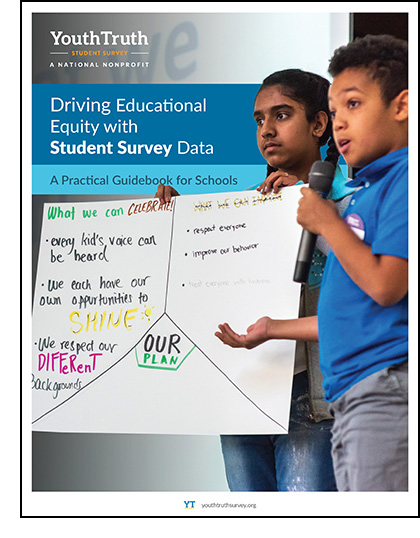
In line with YouthTruth’s commitment to elevating student voices — especially the voices of Black students and students whose voices are too often silenced — earlier this month YouthTruth launched a new resource, “Driving Educational Equity with Student Survey Data: A Practical Guidebook for Schools.”
YouthTruth harnesses student and stakeholder feedback to help school leaders and education funders make better decisions that lead to better outcomes for students. Through validated survey instruments for students, family, and staff, as well as tailored advisory services, YouthTruth partners with schools, districts, states, and education funders to enhance learning for all students.
Drawing on nuanced data about students’ lived experiences, the Guidebook offers school and district leaders and education funders:
- best practices for exploring student survey data with an equity lens;
- examples of how other educators are leading through listening; and
- research-based protocols and practical tips for discussing and taking action to address inequities in school systems.
As Elisha Smith Arrillaga, executive director of Education Trust–West and a member of YouthTruth’s advisory board, writes in the Guidebook’s foreword, “The history of progress toward justice in this country is clear: the best solutions are informed by and designed around the people closest to the problem. In an educational context, that means that if we are not listening to students — especially low-income students, students of color, and others whose voices are routinely drowned out — we are not truly supporting them.”
Download the Guidebook for free here. And for more on the importance of listening to student voices right now, read this recent blog post from YouthTruth Executive Director Jen Wilka.
CEP in the News
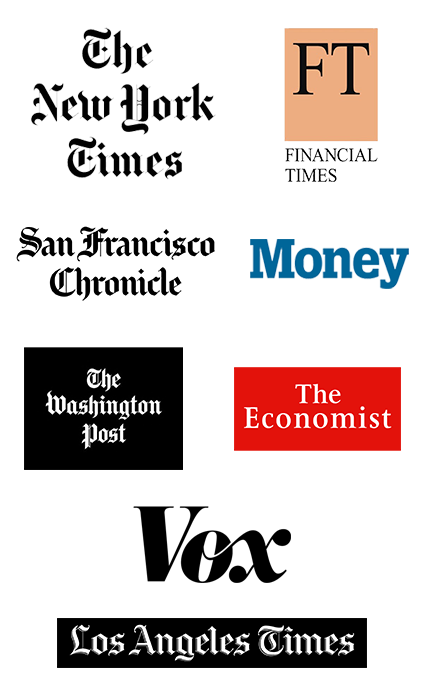
In the past several months, CEP’s research has been cited, and leaders have penned op-eds or been quoted, in a number of media outlets covering how philanthropy and nonprofits are experiencing and responding to COVID-19, as well as the protests for racial justice sweeping the country.
In The New York Times’ story breaking the news of five foundations’ intentions to increase their current spending utilizing what is for philanthropy an unconventional model of issuing debt, journalists James B. Stewart and Nicholas Kulish point to data in CEP’s latest research showing how many nonprofits are “fighting for their survival.”
A Financial Times piece on the surge of donations to civil rights groups following the murder of George Floyd also cited the study, specifically the finding that 80 percent of nonprofits have tapped or expect to tap their reserves, and the degree to which organizations working with disadvantaged populations have been challenged by the COVID-19 crisis. The influx of donations “comes at a time when so many nonprofits, especially those working with marginalized and vulnerable communities, including communities of color, are absolutely reeling,” CEP President Phil Buchanan is quoted as saying in the article.
In an op-ed in The San Francisco Chronicle, Buchanan describes how nonprofits are stepping in where governments and businesses failed — and makes the case for the necessity of a robust philanthropic response to support them.
Buchanan is also quoted in a Money magazine story on how donors can effectively support the fight for racial justice around the country right now. “Find the organizations that are working at the community level — if possible, organizations that are led by people who are in those affected communities, from those affected communities, and figure out how to support them,” Buchanan says.
And the April 2 joint statement from leaders of nine national philanthropy-serving organizations, including CEP, calling on philanthropic funders to significantly increase their grant spending in light of the current crises was cited in several mainstream media articles on the philanthropic response to the pandemic, including ones in The Washington Post, The Economist, Vox, and The Los Angeles Times.
A Year in Review: Read CEP’s 2019 Annual Report
Three new research publications; 115 assessment and advisory services engagements with 95 partners across eight countries; one national conference; and more than 342,000 students surveyed by YouthTruth — these are several of the ways in which CEP worked toward our mission in 2019. Learn more about CEP’s activities last year in our recently published 2019 Annual Report.
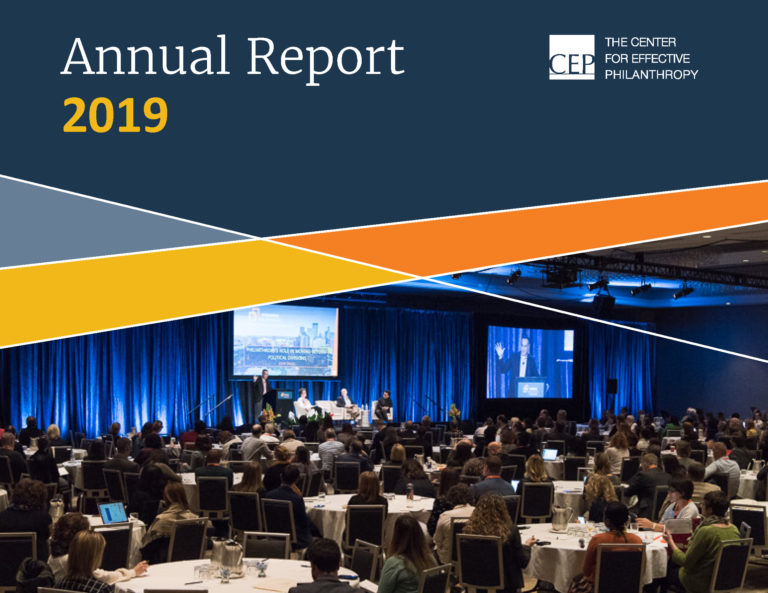
On the Blog
Anthony Richardson, executive director of Nord Family Foundation and a member of the CEP Board of Directors, lays out six practices that foundations can adopt to address racial bias within their organizations and grantmaking. “Any effort to build race consciousness within an organization should be owned and driven by everyone in the organization, from the mailroom to the boardroom,” Richardson writes.
CEP President Phil Buchanan discusses race, equity, philanthropy, and what white people can and must do to confront the country’s history and make meaningful differences in the wake of COVID-19 and police violence.
Leaha Wynn, CEP’s manager, people and culture, and diversity and inclusion strategist, explores important questions about philanthropy’s privilege and rethinking “risk” in the current moment
In an essential post for funders seeking to respond most effectively to their grantees’ challenges during COVID-19, CEP Vice President, Assessment and Advisory Services, Kevin Bolduc shares six tips for listening well right now.
Miles Wilson, deputy director of education grantmaking at Ascendium Education Group, closes his five-part series on social justice and a relevant philanthropic sector with a powerful message: “At the end of the day we in philanthropy must ask ourselves one simple question: in what kind of society do we want to live? Then we must act on what should be an obvious answer.”
Amid all the other urgent challenges philanthropy is being called on to address right now, it also needs to protect and preserve its investment in the arts, argues Fund for Shared Insight Communications Director Rick Moyers.
FJC – A Foundation of Philanthropic Funds Chief Executive Officer Sam Marks reflects on what FJC’s recent collective giving campaign might tell us about the power (and challenges) of mobilizing donor-advised funds (DAFs) in a time of crisis.
LaTida Smith describes how learning to listen prepared Moses Taylor Foundation, the organization she leads, for its COVID-19 response.
Is the dilemma many funders are facing between spending now or spending later a false choice? Hilary Pearson, former founding president of Philanthropic Foundations Canada, explains why that may be the case.
Also exploring this question, a post from Phil Buchanan excerpting from his book, Giving Done Right, contends that perpetual foundations should seek to be counter-cyclical forces by increasing spending during times when grantees are under pressure. (And, Buchanan argues, they can do so without jeopardizing their future existence.)
EPIC-Africa Co-Founders Adwoa Agyeman and Rose Maruru discuss why strengthening civil society organizations in Africa is key to building a vibrant philanthropic ecosystem on the continent.
Kim Dadisman and Caroline Garau of J-PAL North America share four evidence-driven recommendations for donors seeking to effectively support K-12 education during the COVID-19 pandemic.
Reserve your spot to participate in a CEP assessment this year!
If you’re thinking about how you can best deploy your resources to make a meaningful difference right now, collecting and learning from candid, actionable feedback from grantees, staff, donors, or other stakeholders can help. Contact Austin Long to learn more about participating in any of CEP’s assessments or advisory services, or CEP’s rapid-response feedback survey, in 2020.
Support CEP
If you believe in CEP’s work, and if it benefits you and your organization as you seek to do yours, please consider making a grant or an individual contribution to CEP. Supporting CEP means supporting more effective philanthropy
